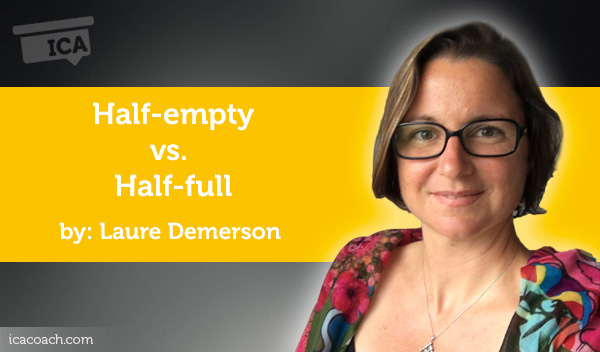
A Coaching Power Tool Created by Laure Demerson
(Life & Transformational coach, SINGAPORE)
A pessimist sees difficulties in every opportunity, an optimist sees opportunities in each difficulty. Winston Churchill
The world is what we think it is. Imagine a glass, half of its volume is filled with water . Some people will see it half-full and some others half-empty. And they are both right. The glass is indeed half-full of water, or half-empty of water, and the one that sees it half-full is not more right than the one who sees it half-empty. They are both only concentrating on one of the two parts of the glass, which has the effect to make it more important to their mind.
Looking at the glass half-empty
People looking at the “half-empty glass” are focusing on difficulties, bad news, the negative things, what they have lost, and today’s issues, seeing only dead ends, highlighting the difficulties they have faced or will potentially face. With such a state of mind, it is highly likely that the days to come will be painful, sad, un-motivating and finally paralyzing onward moves, because such an attitude drains people’s energy.
Looking at the glass half-full
Looking at the glass half-full is when you pay a more supported attention on the good and the beautiful. The optimistic view is the conscious use of our freewill and our ability to see reality under a perspective that will give us good reasons to feel good. In other words, see the half-full glass, and it is highly likely that this period is positively transformed.
Coaching applications
Seeing the glass half-empty can also be seen as a strategy to predict the worse and use one’s ability of anticipation to address the challenges with extreme efficiency. It can be defined as a “strategy that helps us accept our anxious thoughts instead of denying them, a process that will transform negative thoughts into actions and that helps us reach our objectives.”
However, pessimism, carried to excess can be problematic. Pushed to extreme, defensive pessimism while exhausting from the preparation of improbable disaster is not good, in terms of energy level and requirement for example.
On the other hand, seeing the glass half-full can be very pleasant: less complaints, enjoy what you have, being able to perceive the positive elements of a situation, understand how a challenge has led to whom we are now, etc…
As for pessimism, optimistic excess might also lead to unproductive side effects. Optimistic people might fix very high expectations in an important event or situation, and will then avoid digging into the way things underwent. In case of failure, they have a tendency to deny their responsibility by reporting it on external causes. Beside this, excessive optimism will prevent from questioning the risks, doubts and possibilities proposed by the half-empty glass point of view. And last but not least, excess optimism prevents from hearing the messages that our negative emotions are sending (labelled half-empty glass).
The third counterpart to pessimism and optimism could be realism, which will bring you to realize that the glass is not half full or half empty, it is half full and half empty.
Reality is not that we live in a world where people are hungry, reality is that we live in a world where some people are hungry and some eat every day. Reality is not that we live in a world at war, reality is that some people fight every day to survive and some live peacefully…
To see the world as happy or as sad does not change anything to the world. The world is as it is. What changes is you, your perception, what changes is the half of the glass you are deciding to focus on.
Despite the potential risk of an excess of optimism mentioned above, it remains the best way to live a happy, colorful life, full of energy, to look forward, and to be hopeful and confident about the future or the success of something. Optimism is a form of positive
thinking that includes the belief that you are responsible for your own happiness and that more good things will continue to happen to you in the future. By seeing or working on developing an optimistic way of seeing the things, one will, with no doubt, journey towards more happiness.
With this in mind, coaching applications include:
Even if you go through a though time, you can always ask yourselves the question: ” what do I have to learn of this situation? What profit may I remove from it? “, look, you will find …
While remaining realistic is being able to understand that there is positive and negative in anything or circumstances, it is of your personal power to prefer to focus on one of the two aspects and to modify your filters of perception. You will be highly empowered in learning this competency to be able to choose to adopt optimist or pessimist strategy in life, depending on the situations and on your needs in these situations. And this decision belongs only to you, and to you only.
Conclusion
The happiness which you deserve thus is before any a decision to take the appropriate look at you, the situations, and naturally the beings. By putting on these new glasses, you make of every day which passes, a chance to see opportunities and hope, where the others might see only dead ends.
The optimist and the pessimist both contribute to our society. The optimist invents plane while the pessimist invents parachute. Gil Stern
As a coach, how would you deal with a client who always sees negatives & the dark side of every thing? Who always on a bucket-dipping mode?
As a coach, how would you keep your bucket full for your client?